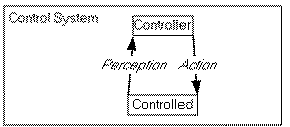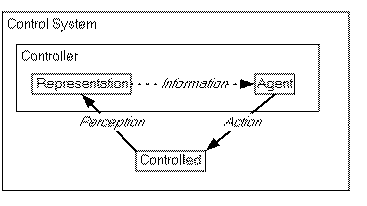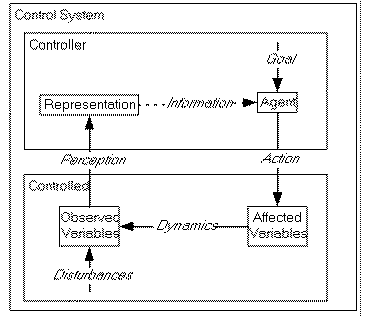Control
Figure 1:

Control is the operation mode of a control system which
includes two subsystems: controlling (a controller) C,
and controlled, S.
They interact, but there is a difference between the action of C
on S, and the action of S on C. The controller C may change
the state of the controlled system S in any way, including
the destruction of S. The action of S on C is formation
of a perception of system S in the controller C.
This understanding of control is presented in Fig.1.
Figure 2:

In Fig.2 we define the concept of perception. We see in the controller
an agent which is responsible for its actions, and a
representation of the controlled system, which is an object
whose states we identify with perceptions.
The relation between representation and agent is described as a flow of
information: the actions of the agent depend on this flow.
Thus the action of S on C is limited, in its effect, by changing
only S's representation in C, not the rest of the system.
Thus the asymmetry of the control relation: C controls S,
but S does not control C. The action of S on C is "filtered"
through the representation: its effect on C cannot be greater
than allowed by the changing state of the representation.
Of course, two systems can be in a state
of mutual control, but this will be a different, more complex,
relation, which we will still describe as a combination of two
asymmetric control relations.
Figure 3:

In many cases the controlled system can be also seen in greater detail,
which is done in Fig.3. We describe the controlled system
using some variables and distinguish
between the variables directly affected by the controller, from
the variables which are observed by the controller in perception.
The causal dependence of the observed variables on the affected variables
is determined by the intrinsic dynamics of the system.
We also must not forget about the effect of uncontrollable disturbances
on the observed variables.
In Fig.3 we also made an addition to the controller: it now includes
one more object which influences the agent: goal. The agent
compares the current representation with the goal and takes actions
which tend to minimize the difference between them.
This is known as purposeful behavior.
It does not necessarily result from the existence of
an objectified goal; the goal may be built into the system --
dissolved in it, so to say. But a typical control system would
include a goal as a an identifiable subsystem.
Even though the relation of control is asymmetric, it includes a closed
loop. Looked from the controller, the loop starts with its action
and is followed by a perception, which is an action in the opposite
direction: from the controlled to the controller. This aspect of
control relation is known as feedback.
The concept of control is the cornerstone of cybernetics.
The basic control scheme which we have defined in this node
is the unit from which complicated cybernetic systems are created
by nature and man. For this reason, our definition is pretty wide:
we want our building unit to be as universal as possible.
In particular, we see as special cases of control some systems
which most present authors would, probably, not call control.
The different components (e.g. perception, action, ...) of the control loop we have enumerated can in the limit be absent. This leads to different "degenerate" or "limit" cases, which we would not usually see as control systems, but which still share many properties with the more elaborate control scheme. Specific instances of this control scheme can further differ in the presence or absence of different attributes or properties characterizing control systems: separability, contingency, evolvability, asymmetry, ... This leads to a very broad view of control in which many very important types of system can be classified, as shown by many examples of control systems. The abstract scheme can also be mapped on different other schemes for control by authors such as Ashby, Powers and Meystel, and on an older definition in terms of statements and commands.
Mis à jour le 01/04/2016  pratclif.com
pratclif.com



![]() pratclif.com
pratclif.com